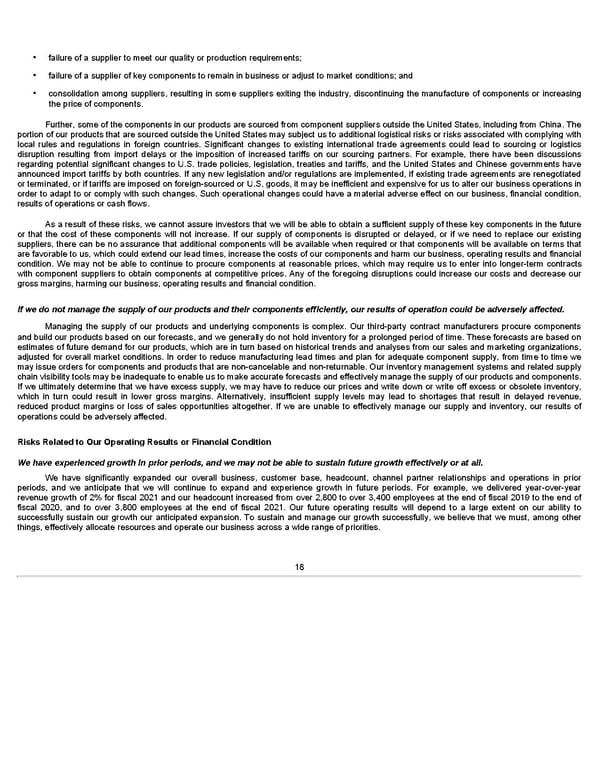• failure of a supplier to meet our quality or production requirements; • failure of a supplier of key components to remain in business or adjust to market conditions; and • consolidation among suppliers, resulting in some suppliers exiting the industry, discontinuing the manufacture of components or increasing the price of components. Further, some of the components in our products are sourced from component suppliers outside the United States, including from China. The portion of our products that are sourced outside the United States may subject us to additional logistical risks or risks associated with complying with local rules and regulations in foreign countries. Significant changes to existing international trade agreements could lead to sourcing or logistics disruption resulting from import delays or the imposition of increased tariffs on our sourcing partners. For example, there have been discussions regarding potential significant changes to U.S. trade policies, legislation, treaties and tariffs, and the United States and Chinese governments have announced import tariffs by both countries. If any new legislation and/or regulations are implemented, if existing trade agreements are renegotiated or terminated, or if tariffs are imposed on foreign-sourced or U.S. goods, it may be inefficient and expensive for us to alter our business operations in order to adapt to or comply with such changes. Such operational changes could have a material adverse effect on our business, financial condition, results of operations or cash flows. As a result of these risks, we cannot assure investors that we will be able to obtain a sufficient supply of these key components in the future or that the cost of these components will not increase. If our supply of components is disrupted or delayed, or if we need to replace our existing suppliers, there can be no assurance that additional components will be available when required or that components will be available on terms that are favorable to us, which could extend our lead times, increase the costs of our components and harm our business, operating results and financial condition. We may not be able to continue to procure components at reasonable prices, which may require us to enter into longer-term contracts with component suppliers to obtain components at competitive prices. Any of the foregoing disruptions could increase our costs and decrease our gross margins, harming our business, operating results and financial condition. If we do not manage the supply of our products and their components efficiently, our results of operation could be adversely affected. Managing the supply of our products and underlying components is complex. Our third-party contract manufacturers procure components and build our products based on our forecasts, and we generally do not hold inventory for a prolonged period of time. These forecasts are based on estimates of future demand for our products, which are in turn based on historical trends and analyses from our sales and marketing organizations, adjusted for overall market conditions. In order to reduce manufacturing lead times and plan for adequate component supply, from time to time we may issue orders for components and products that are non-cancelable and non-returnable. Our inventory management systems and related supply chain visibility tools may be inadequate to enable us to make accurate forecasts and effectively manage the supply of our products and components. If we ultimately determine that we have excess supply, we may have to reduce our prices and write down or write off excess or obsolete inventory, which in turn could result in lower gross margins. Alternatively, insufficient supply levels may lead to shortages that result in delayed revenue, reduced product margins or loss of sales opportunities altogether. If we are unable to effectively manage our supply and inventory, our results of operations could be adversely affected. Risks Related to Our Operating Results or Financial Condition We have experienced growth in prior periods, and we may not be able to sustain future growth effectively or at all. We have significantly expanded our overall business, customer base, headcount, channel partner relationships and operations in prior periods, and we anticipate that we will continue to expand and experience growth in future periods. For example, we delivered year-over-year revenue growth of 2% for fiscal 2021 and our headcount increased from over 2,800 to over 3,400 employees at the end of fiscal 2019 to the end of fiscal 2020, and to over 3,800 employees at the end of fiscal 2021. Our future operating results will depend to a large extent on our ability to successfully sustain our growth our anticipated expansion. To sustain and manage our growth successfully, we believe that we must, among other things, effectively allocate resources and operate our business across a wide range of priorities. 18
 Annua lReport Page 17 Page 19
Annua lReport Page 17 Page 19